|
|
|
Sort Order |
|
|
|
Items / Page
|
|
|
|
|
|
|
| Srl | Item |
| 1 |
ID:
090448
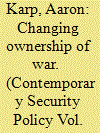

|
|
|
|
|
| Publication |
2009.
|
| Summary/Abstract |
As the state loses not only its Weberian monopoly over legitimate violence, but also its control over military initiative and dominance of military technology, what forces lead the redefinition of the ends and means of armed violence? If non-state armed groups are understood as the new owners of war, how must our understanding of the artefacts of violence adapt as well? This article examines the effects of changes in the legitimacy of violence on its physical manifestations. Weapons technologies have ceased to be an independent variable of violence and become consequences of strategic and doctrinal choice. As states lose the ability to use technology to regulate warfare, technological virtuosity no longer is defined by the state, but by the initiators of violence. It follows that the most important violent technologies no longer are state-generated. They are adaptations and creations by terrorists and insurgents. This transformation affects priorities and possibilities for control over violent technology. Innovative statist methods - as developed through the Proliferation Security Initiative (PSI) and UNSC 1540 - remain highly relevant, as do Westphalian concepts such as export control and disarmament. Recognizing limits to their effectiveness in an environment where rules are set by non-state actors as much as by states themselves, however, is crucial
|
|
|
|
|
|
|
|
|
|
|
|
|
|
|
|
| 2 |
ID:
090447
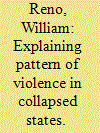

|
|
|
|
|
| Publication |
2009.
|
| Summary/Abstract |
Abstract Analyses of predatory violence that stress individual fighters' pursuits of short-term opportunities for enrichment explain why insurgents seem to be so uninterested in taking time to propagandize, recruit, and organize local populations to fight. International efforts to resolve this kind of conflict often aim to sever this link between resources, conflict, and these short-term goals. Quick opportunities do attract certain kinds of people and shape how they organize and how they fight. But critical cases often are overlooked in analyses linking local resources to propensities for predation. This behaviour may indicate the construction of new institutions that contribute to post-conflict stability such that people with guns obey people without guns. Individual interests are not irrelevant, but present an incomplete picture of the behaviour and organization of insurgents. A more complete explanation entails looking more closely at the relation of insurgents to non-combatants and to the politics of patronage, or the 'state' as it has become in the most extreme examples of state collapse. Historically this obedience to community leadership or to political cadres has been integral to the mobilization of insurgents with political programs and liberated zones, and ultimately,
|
|
|
|
|
|
|
|
|
|
|
|
|
|
|
|
| 3 |
ID:
090440


|
|
|
|
|
| Publication |
2009.
|
| Summary/Abstract |
Violence is one of a range of tactics available to social movements. The important question is not whether violence is a tactic, but why certain groups within particular social movements choose a violent path. Using the cycle of protest model this study maps the progression from localized protest to armed group in a case study of the Niger Delta People's Volunteer Force. The case study demonstrates how an armed group emerges from a broader social movement, what influences this evolution, and what enables the armed group to sustain itself when facing significantly higher costs for survival. For the Niger Delta People's Volunteer Force, competition for scarce resources, its ideology justifying an aggressive posture toward government, and its capacity to mobilize necessary resources to engage in a violent struggle with the government all played significant roles in the emergence and survival of the group
|
|
|
|
|
|
|
|
|
|
|
|
|
|
|
|
| 4 |
ID:
090441
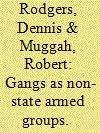

|
|
|
|
|
| Publication |
2009.
|
| Summary/Abstract |
Gangs are popularly considered to be the major security threat facing the Central American region. In focusing on the origins and dynamics of gangs in the region, this article seeks to broaden conceptualizations of non-state armed groups by expanding the theoretical optic from a narrow focus on war and post-war contexts to a wider spectrum of settings, actors, and motivations. It highlights a category of actors that does not explicitly seek to overthrow the state, but rather progressively undermines or assumes certain state functions. The article also reveals how efforts to contain and regulate gangs flow from their imputed motives, with interventions influenced by whether they are conceived as a criminal or political threat. At the same time, coercive regulation tend to be favoured even when such repressive interventions exacerbate gang violence, for reasons that reveal the deeper underlying political, social, and economic challenges facing the Central American region.
|
|
|
|
|
|
|
|
|
|
|
|
|
|
|
|
| 5 |
ID:
090437
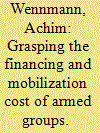

|
|
|
|
|
| Publication |
2009.
|
| Summary/Abstract |
This paper approaches conflict financing as a combination of available revenue sources and the cost to start and maintain armed conflict. The paper therefore goes beyond conceptualizations of conflict financing that only look at the total available revenue of armed groups. Based on recent small arms research, the paper sketches a tool to estimate the mobilization cost of armed groups with the objective to establish data points for barriers to entry into armed conflict and the cost of competition during armed conflict. The paper argues that what matters in conflict financing is to identify the financing and mobilization costs together, and if an armed group can pay for the type of conflict required to reaching its objective. The paper contributes to an evolving literature on the feasibility of conflict and provides a new perspective on conflict dynamics with implications for peace processes, peacebuilding, and policy against conflict financing.
|
|
|
|
|
|
|
|
|
|
|
|
|
|
|
|
| 6 |
ID:
090429
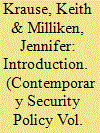

|
|
|
|
|
| Publication |
2009.
|
| Summary/Abstract |
The study of non-state armed groups (NSAGs) has traditionally been limited to those actors with a political agenda that pose a specific threat to the state and undermine its ability to claim a monopoly over the legitimate use of force within its territory. In contrast, this introduction - and the articles that follow - expands upon this narrow conceptualization and redefines NSAGs to encompass such actors as militias, warlords, private security providers, urban gangs, and transnational and criminal networks. This understanding facilitates a wider exploration of how such groups form in relation to the state, and how the state in turn is shaped through its interactions and conflict with the armed group(s). This article provides an overview of a set of research issues, frameworks, and methods that represent a starting place for a broadened agenda on armed groups which moves beyond those actors who mount direct challenges to the Weberian state. A more nuanced understanding of the different forms and historical trajectories of the interactions between armed group and states also highlights the dynamics through which various types of violent actors influence the use of force and violence in contemporary world politics.
|
|
|
|
|
|
|
|
|
|
|
|
|
|
|
|
| 7 |
ID:
090432


|
|
|
|
|
| Publication |
2009.
|
| Summary/Abstract |
a world of growing security challenges, non-state armed actors have captured significant attention from scholars concerned with regime stability and the consolidation of national states. But the preoccupation with national political dynamics has eclipsed the study of non-state armed actors who struggle to secure economic dominion, and whose activities reveal alternative networks of power, authority, independence, and self-governance unfolding on a variety of territorial scales both smaller and larger than the nation-state. With a focus on actors as wide-ranging as private police, gangs, and mafias, this article charts the proliferation and significance of non-state armed action structured around economic activities, and assesses the nature of violence and insecurity generated by these activities in comparison to more conventional politically oriented non-state action. Drawing evidence primarily from middle-income countries of the global south, where political regimes are relatively more stable but a wide variety of non-state armed actors still proliferate,
|
|
|
|
|
|
|
|
|
|
|
|
|
|
|
|
| 8 |
ID:
090443


|
|
|
|
|
| Publication |
2009.
|
| Summary/Abstract |
Despite the ousting of the Taliban and a subsequent peace agreement reached at the end of 2001, Afghanistan continues to struggle with insecurity. The existing security deficit of the Afghan state is currently filled by a wide array of (armed) non-state actors (ANSA). Even though much of the Afghan experience with ANSA has been negative, the inability of the state to provide comprehensive security necessitates a consideration of alternatives. One of such possible alternative, the community-based policing structure in south-eastern Afghanistan (arbakai) is explored in this article. We conclude that it is important to understand the context-specificity of ANSA before promoting overarching policies such as advocating a transferability of the arbakai outside their unique cultural and regional context. We also caution against the use ANSA beyond their capacities, such as for counter-insurgency purposes and formalize engagement with clear parameters to ensure accountability.
|
|
|
|
|
|
|
|
|
|
|
|
|
|
|
|
| 9 |
ID:
090446
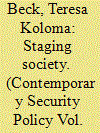

|
|
|
|
|
| Publication |
2009.
|
| Summary/Abstract |
Staging Society
Loyalty
Angolan UNITA
UNITA
|
|
|
|
|
|
|
|
|
|
|
|
|
|
|
|
| 10 |
ID:
090434
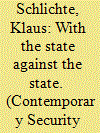

|
|
|
|
|
| Publication |
2009.
|
| Summary/Abstract |
In a world of growing security challenges, non-state armed actors have captured significant attention from scholars concerned with regime stability and the consolidation of national states. But the preoccupation with national political dynamics has eclipsed the study of non-state armed actors who struggle to secure economic dominion, and whose activities reveal alternative networks of power, authority, independence, and self-governance unfolding on a variety of territorial scales both smaller and larger than the nation-state. With a focus on actors as wide-ranging as private police, gangs, and mafias, this article charts the proliferation and significance of non-state armed action structured around economic activities, and assesses the nature of violence and insecurity generated by these activities in comparison to more conventional politically oriented non-state action. Drawing evidence primarily from middle-income countries of the global south, where political regimes are relatively more stable but a wide variety of non-state armed actors still proliferate, it examines the new 'spatiality' of non-armed state action directed toward economic sovereignty, argues that it forms the basis for alternative imagined communities of allegiance, and assesses the implications for the future of the traditional nation-state.
|
|
|
|
|
|
|
|
|
|
|
|
|
|
|
|
|
|
|
|
|